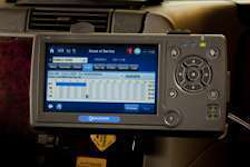 California Air Resources Board may continue to enforce its regulation of transportation refrigerated units.
California Air Resources Board may continue to enforce its regulation of transportation refrigerated units.California may continue enforcing its restrictions on transportation refrigerated units as a result of a ruling April 2 by the U.S. Court of Appeals for the District of Columbia Circuit.
The court rejected a challenge by the American Trucking Associations and the Truckload Carriers Association to a U.S. Environmental Protection Agency action allowing the California regulation to move forward.
At issue in the case was EPA’s grant of a waiver to the California Air Resources Board on Jan. 16, 2009, allowing the agency to enforce the TRU regulations, which were adopted in February 2004. The regulations mandate reductions in engine emissions by requiring that TRUs equipped with diesel engines that are seven years or older be replaced or retrofit with new engines or verified diesel emissions control strategies, or VDECS. Or operators can use alternative technologies such as electric-standby/hybrid-electric or hybrid-cryogenic systems.
CARB originally had planned on the rules taking effect in December 2004, but it needed the EPA waiver to implement them. After receiving the waiver, CARB initially announced a July 16, 2009, enforcement date and eventually delayed enforcement until Dec. 31, 2009. In January and February alone, the agency issued citations totaling more than $180,000 in penalties for failing to register equipment and failing to meet emissions requirements, CARB said last month.
Under the Clean Air Act, California – and California alone – may set limits on emissions from in-use nonroad engines, such as the TRU on a refrigerated truck or trailer. Other states can regulate such engines only if they adopt regulations identical to California’s rules. EPA’s only role is to review California’s proposed rules under a narrowly defined set of statutory criteria. By law, EPA must approve a California in-use nonroad engine regulation unless it finds that the state:
# Unreasonably determined that its rule is at least as protective of public health and welfare as the relevant federal standards;
# Does not need the proposed standard to meet “compelling and extraordinary conditions” in California; or
# Precludes other states from choosing not to regulate or imposes excessive costs.
ATA and TCA challenged EPA’s waiver decision, arguing that the federal agency incorrectly concluded that California needed the specific TRU rule in order to meet “compelling and extraordinary conditions” in the state. The groups also contended that because many trucks from throughout the United States must pass through California, the state’s regulation is a “de facto national rule,” effectively precluding other states from choosing not to follow California’s lead. In addition, ATA, which was the lead plaintiff, and TCA argued that EPA failed to consider the cost of compliance appropriately.
The appeals court sided with EPA on all points. EPA concluded that “compelling and extraordinary conditions” refers to the factors that tend to cause pollution – geographic and climatic conditions combined with large numbers and high concentrations of automobiles. “The expansive statutory language gives California (and in turn EPA) a good deal of flexibility in assessing California’s regulatory needs,” the appeals court said. Regarding costs, the court noted that EPA only had to consider costs and that the agency had done so. Businesses can comply for about $2,000 to $5,000 per unit, and the phased implementation would minimize the cost, EPA had found.
The argument that California’s TRU regulations effectively deny other states their right not to regulate is weak because California does not require any state to adopt its approach and because it only applies to vehicles that have entered California, the appeals court said. “If ATA’s members operate trucks in California, they must comply while operating in California. If they do not operate in California, they need not comply. We find nothing about this approach to be inconsistent with the federal statutory scheme,” the court said.
“ATA’s argument is best directed to Congress because the problem it identifies is inherent in the congressional decision to give California the primary role in regulating certain mobile pollution sources,” the appeals court said. In a footnote, the court added that if ATA is concerned that California’s rule unconstitutionally burdens interstate commerce, it could attempt to bring a constitutional challenge directly to the California rule. “We express no view on that possibility,” the court said.
The court’s conclusions regarding ATA’s “de facto national standard” argument weren’t unanimous, however. In a partial dissent, Judge Stephen Williams said that EPA did not consider ATA’s claim sufficiently. The closest EPA comes in considering ATA’s argument is when the agency simply declares that nothing in the statute confines California to regulation of engines that operate solely or even a majority of their time in California. “Really? By this language, it would be perfectly all right for the California rule to say that no vehicle may enter California if any other vehicles, anywhere in the United States and owned by the same firm, were noncompliant with the California standard,” Williams said.
The appeals court ruling comes as CARB is considering changes to the TRU regulations. For example, the agency may relax the in-use emissions standards for model year 2003 TRU engines of 25 hp or greater and for model year 2003 and 2004 engines of 25 hp or less. CARB also is considering requirements for electric standby-equipped TRUs to demonstrate they are operated without a diesel engine at all facilities.










